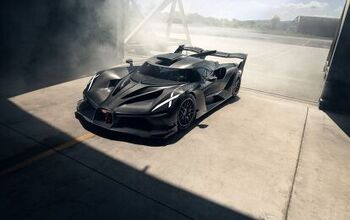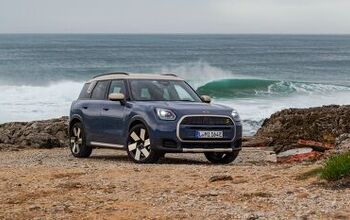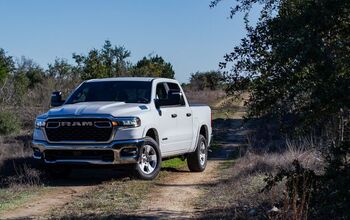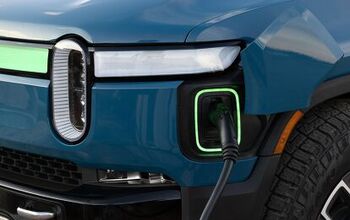Top 10 Forgotten Supercars That Deserve to Be Remembered
Just as the pop charts are filled with one-hit wonders, the automotive industry has more than a few shining stars that burned out pretty quickly.
Nowhere is this more apparent than in the world of supercars — the lofty dovetailing of price and performance often leads boutique brands to soar like Icarus towards the sun only to be felled by economic reality and the truly difficult process of actually transforming a breathtaking concept into a production vehicle.
Check out our picks for 10 forgotten supercars that didn’t deserve to be relegated to the dust heap.
1. Cizeta V16T
Giorgio Moroder gave the world the 12-inch extended mix in the 1970s because he didn’t feel like getting up to flip the record over while entertaining amorous companionship. In 1988, the renowned music producer added “16-cylinder supercar builder” to his resume with the Cizeta V16T, a wedge-shaped coupe designed in conjunction with Claudio Zampolli (a Ferrari dealer) and Marcello Gandini (of Lamborghini Countach fame). In fact, what ended up becoming the V16T started life as a development concept for the Lamborghini Diablo before the Chrysler-controlled company passed on it for being too wild. Like Moroder’s music, the Cizeta pushed boundaries with its quad-pop-up headlights, its transversely mounted, 560-horsepower 16-cylinder engine, and its 203-mph top speed.
Why haven’t I heard about it? Moroder had a falling out with Zampolli before the car entered production, and the company cut his name off of the badge. What had been a music biz novelty slid into the realm of obscure Italian exotics, and the company went out of business in 1995 after having built 19 vehicles over a four-year run. Since then, the Cizeta V16T has been built on-spec for at least three customers and was advertised as being available until the mid-2000s.
Photo from supercars.net
2. Mosler Consulier GTP
Sometimes, success on the race track doesn’t translate into “sell on Monday.” Almost right from its introduction in 1985, the Mosler Consulier GTP was such a menace in IMSA racing due to its lightweight design (the coupe weighed in at a mere 2,200 lbs) that it was banned in 1991. The car also was the first production automobile to feature carbon fiber and Kevlar in its body panels while riding on a monocoque that featured no structural metals such as aluminum or steel. Mosler put up $25k cash to anyone who could beat the GTP on a race track in a street-legal car.
Why haven’t I heard of it? The Consulier GTP’s 2.2-liter Chrysler-sourced turbo four-cylinder engine was good for just 190 horsepower, making it relatively meek among contemporary supercars. While racers might have appreciated it, it wasn’t until original designer Randy Mosler split from Consulier and started stuffing Corvette V8s into the car (renaming it the Mosler Intruder and the Mosler Raptor, depending on configuration), that the public started to take notice.
Photo from CarThrottle
3. Aixam Mega Track
France’s Aixam Mega Track dared to answer the question that no one has ever asked: “Why can’t I adjust the suspension on my 394-horsepower, 12-cylinder exotic to give me 13 inches of ground clearance?” Built by a company better known for its tiny-displacement city cars (the brand had to borrow a Mercedes-Benz V12 for the Mega Track), as wide as a Hummer H1, and riding on 20-inch wheels all the way back in 1993 when 17-inches was considered ultra-swag, the Aixam Mega Track probably deserves as much credit as the Subaru Outback for inspiring that decade’s crossover craze. Why should your supercar be defeated by an obstacle as simple a sand dune or burbling brook?
Why haven’t I heard of it? There are only five Mega Tracks in existence because Aixam decided to take the Mega sub-brand and head in a different direction with the more traditional Mega Monte Carlo (if a 720-horsepower twin-turbo V12 and a carbon-fiber monocoque can be considered “traditional”) in the mid-90s.
Photo from AutoWeek.nl
4. Yamaha OX99-11
Although it built Formula 1 engines for over a decade, few are aware of the important role Yamaha has played in tuning performance cars like the original Ford Taurus SHO and Lexus LFA. When the company first got involved with F1 in the late ’80s, it decided that would be the perfect time to leverage its 12-cylinder racing investment in the form of a street-going supercar with the worst name ever. The OX99-11 had a 3.5-liter V12 (which delivered 400 horsepower at 10,000 rpm), and it featured a one-of-a-kind “dual tandem” cabin arrangement in the middle of the car where driver and passenger sat one after the other under a glass bubble canopy surrounded by a carbon fiber shell.
Why haven’t I heard of it? The OX99-11 never officially made it into production after squabbles with original engineering caused it to be handed back to Yamaha’s U.K.-based Ypsilon Technology F1 brain trust. Substantial delays led to the project being killed by 1994 after just three prototypes were built.
Photo from Wikipedia
5. Isdera Imperator 108i
Haven’t you always wanted a supercar with a periscope? If you’ve ever tried to back an ’80s-era exotic into a parking space, then the answer has to be yes, which puts the Isdera Imperator 108i at the No. 1 spot on your shopping list. A flattened tear drop with gullwing doors and a weirdly Roman name, the Imperator 108i was a product of Eberhard Schulz’s active imagination, a man who had been part of the engineering team behind the Mercedes-Benz CW311 concept from the first half of the 1970s. Introduced in 1984, Schulz based the drivetrain in this particular Isdera around MB mechanicals, using both 5.0-liter and 6.0-liter versions of the company’s M117 V8 engine (with the latter producing over 400 horsepower). Thirty versions of the Imperator 108i were sold, each with a top speed of 176 mph.
Why haven’t I heard of it? Likely because it was the V12-powered, gullwinged Isdera (an acronym for Ingenieurbüro für Styling, DEsign und RAcing) Commendatore 112i that was featured in Need For Speed II, rather than its Imperator predecessor, dooming it to irrelevance amongst the digital generation.
Photo credit: German Cars for Sale Blog
6. Panther 6
Back when Formula 1’s rulebook was a little more open-minded, a man named Derek Gardner came up with the Tyrrell P34, a six-wheeled racer that hit the podium numerous times during its two-year run in the series. We’re willing to bet that Robert Jankel, the creator of the bonkers Panther Six, was more than a little inspired by the Tyrrell effort. With four wheels of steering at the front and a mid-mounted twin-turbocharged 8.2-liter Cadillac V8 sending roughly 600 horsepower to the rear axles by way of a three-speed automatic transmission, the car boasted a claimed 200-mph top speed when it first went on sale in 1977. It also featured an on-board television set, two phones (one in each armrest), and a safe.
Why haven’t I heard of it? Jankel was actually a fairly successful automotive designer, having accidentally transitioned from the world of fashion to building hand-made performance cars in the early ’70s after being shocked by the street price of a classic Jaguar. His retro-inspired designs found a welcoming audience among the wealthy, but a combination of supplier issues and financial solvency meant that only two Panther Six models were ever built, both of which survive to this day.
Photo credit: Panther Car Club
7. Covini C6W / C3A 3 Axis
Wait, another six-wheeled supercar? This one also draws its roots from Tyrrell, but it took much longer to get to market than the Panther. Although initial plans for the Covini C6W were first laid out in 1974, parts problems similar to those that plagued the Panther 6 (specifically, tiny performance tire availability) had it slumbering until 2003, when Covini Engineering paired up with PMI SpA to finally bring its car to market by the end of that decade. Featuring a unique Brembo six-channel ABS system, an Audi-sourced 4.2-liter V8 generating 434 horsepower, and a six-speed manual gearbox, the Covini is being produced in extremely low numbers and has a top speed of 185 mph.
Why haven’t I heard of it? Covini is a family affair, with company principle Gianluca Covini picking up his father’s torch decades after he was forced to give up. Hand-built cars that take 30 years to get from the drawing board to the concept stage are the very definition of a “slow burn.”
Photo credit: Serious Wheels
8. Lotec C1000
Long before Ferrari, Porsche, and Bugatti began firing shots at one another in a bid to claim the title of world’s fastest road car, it was up to individuals with unfettered access to millions of dollars in disposable income to take up this particular fight. Enter the Lotec C1000, a single-example production car built in 1995 with the sole express purpose of being the quickest vehicle on the planet. Commissioned by an anonymous benefactor from the United Arab Emirates, longtime racing shop Lotec worked for five years on the C1000, which offered a twin-turbo 5.6-liter Mercedes-Benz V8 engine that rocketed the coupe all the way up to a claimed 268 mph.
Why haven’t I heard of it? Unless you lived in the UAE, you probably never saw the C1000 until it started showing up on auction blocks in the 2000s. Originally priced at well over $3-million, the car has sold for as low as $243,000 at Barrett-Jackson before bouncing from one dealership to another in search of someone dreaming the same dream.
Photo credit: Dupont Registry
9. Vector W8
The Vector W8 is perhaps the best cautionary tale in supercardom. Sprung from the intense desire of Vector Automotive Corporation to build an American exotic capable of tackling the best of what Europe had to offer, the Vector W8 was a step up from the earlier W2 model both in terms of power and sheer “max wedge” styling. The automotive equivalent of a doorstop, and perhaps the best representation of ’70s design taken to an ’80s extreme, the W8 was outfitted with a mid-mounted twin-turbo V8 good for 625 horsepower. The coupe was advertised as having a top speed of over 240 mph (depending on which wing was outfitted at the rear), and the W8 could run a 12-second quarter mile @ 124 mph.
Why haven’t I heard of it? Despite two decades of development, fundraising, engineering, and tuning by founder Gerald Wiegert, by the time the W8 went on sale in 1990, there wasn’t much cash left in the tank at Vector. Three years later, the company was history, Wiegert had been turfed by his own board, and the W8 was fading in the rearview mirror. Gerald would later purchase the smoldering remains of Vector and attempt to make a comeback with as-yet-unreleased WX-8.
Photo credit: Petrolicious
10. Nissan R390 GT1
Some of the most intriguing secret supercars have their origins as factory-backed racing prototypes. The Nissan R390 GT was the road-going result of the Japanese automaker’s development program for a 24 Hours of Le Mans GT-class racer at the end of the 1990s, meaning that a street version had to be homologated in order to compete. In a fine bit of cheating, Nissan built the R390 GT in partnership with Ian Callum (then at Tom Walkinshaw Racing) but then never sold it, keeping it in a warehouse where its twin-turbo 3.5-liter V8 will never get the chance to tap into its 550 horsepower.
Why haven’t I heard about it? Unless you’ve been to Nissan’s Zuma warehouse in Japan, you’ve likely never been within 100 miles of the R390 GT at any point in your life. The vehicle serves primarily as an interesting footnote to the beginning of the era where automakers such as Porsche and Mercedes-Benz built race cars first, then created street models loosely based on their track-only cousins, leaving brands like Nissan that played by what they thought were the rules out in the cold.
More by Benjamin Hunting










































Comments
Join the conversation
-still can't believe that big V16 in the Cizeta Moroder was transversely mounted. -i actually saw a Consulier GTP at the Winter Park Concours d' Elegance. -Lotec C1000 is a lot more daring than the Isdera Imperator. -Vector W8 went over 240MPH with only a 3-speed automatic! -Surprised the 3-axle Covini isn't being re-imagined with a TT-RS 5-cylinder. -Most sorry about the OX99-11 never seeing the light of day. 10,000 RPM 3.5 V12 would immediately pole vault straight to the top of all engines of all categories in terms of desirability.